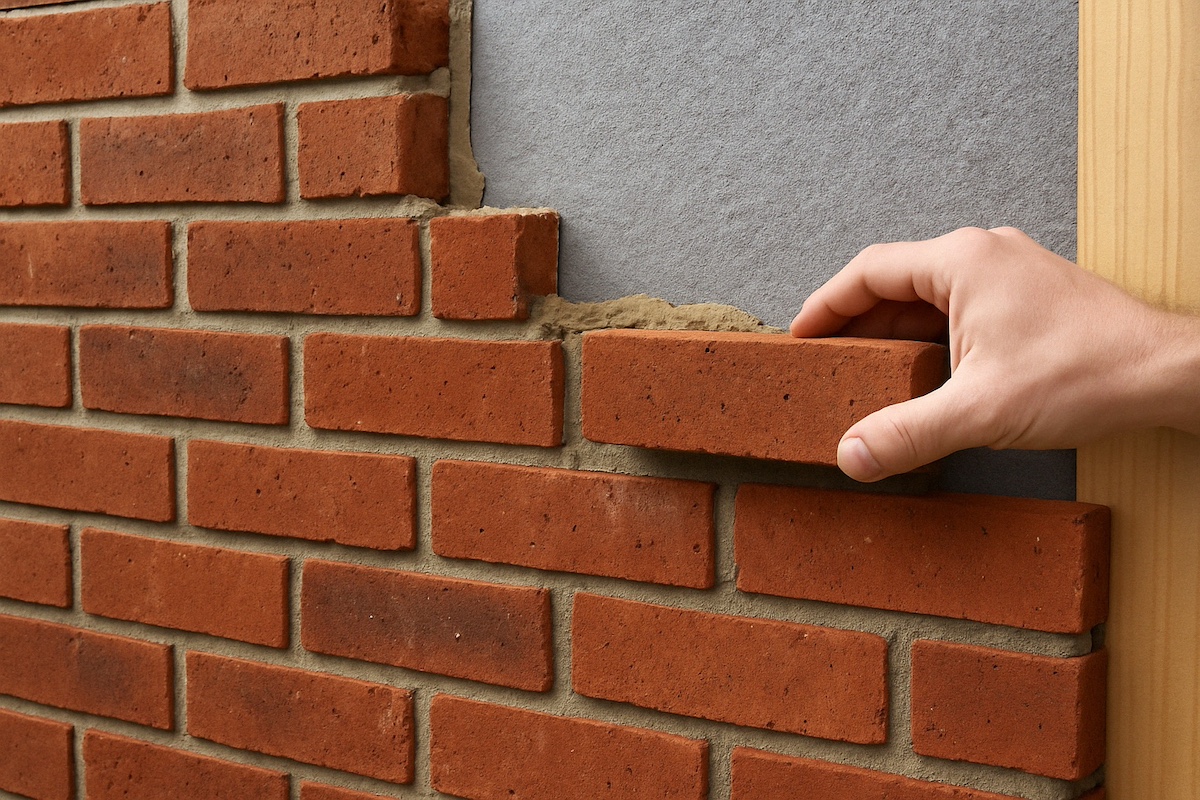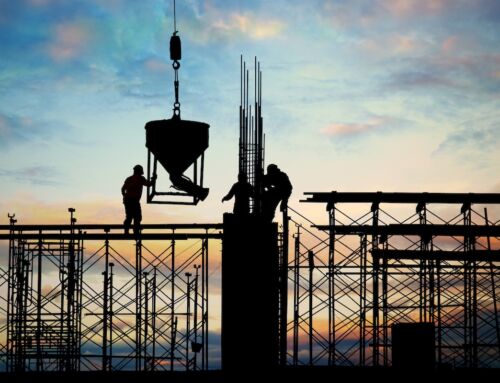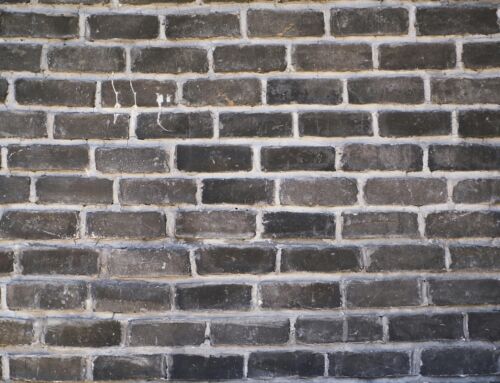Brick veneer is a popular building material used in both residential and commercial construction. It gives the appearance of traditional brick while being lighter, easier to install, and more cost-effective. Despite its visual similarity to solid brick, brick veneer serves a different purpose and is installed completely differently.
In this guide, we’ll explore what brick veneer is, how it compares to solid brick, its advantages and disadvantages, where it’s most commonly used, and how much it typically costs. Whether you’re a homeowner, architect, or contractor, this resource will help you decide if brick veneer is the right fit for your next project.
Understanding Brick Veneer
What is Brick Veneer Made Of?
Brick veneer is made from the same materials as full-sized bricks—typically clay or concrete—but it’s only a thin slice, around ½ to 1 inch thick. It’s designed purely for aesthetic purposes and is not meant to support structural loads. That means it functions more like siding or a cladding material than an integral part of the building’s framework.

Despite being thinner, it retains the visual texture, color, and pattern of standard brickwork. This makes it ideal for projects that want the look of brick without the added weight or cost.
How is Brick Veneer Installed?
Brick veneer installation involves attaching the thin brick pieces to a framed wall (usually made of wood or steel). A weather-resistant barrier is installed first, followed by brick ties or metal anchors that secure the veneer to the frame. A small air gap is typically left behind the brick to allow for ventilation and drainage, which prevents moisture buildup and structural damage.
For interiors, brick veneer can be installed directly onto drywall or cement board using adhesive and mortar.
Brick Veneer vs. Solid Brick (Full Brick Masonry)
Structural Differences
Solid brick (or full brick masonry) is load-bearing and used to support a structure’s weight. It is built in multiple wythes (layers) and requires a strong foundation. Brick veneer, on the other hand, is non-structural and is applied as a façade over an existing wall. This key difference affects everything from engineering requirements to installation techniques and cost.
Aesthetic and Cost Considerations
Visually, it’s almost impossible to distinguish between brick veneer and full brick. However, brick veneer comes out on top when it comes to budget-friendliness, ease of handling, and installation time.
Brick veneer: Lightweight, lower cost, easier to install
Solid brick: Heavier, higher cost, longer installation process
Insulation and Energy Efficiency
Brick veneer is often combined with modern insulation methods, such as foam boards or spray insulation, which enhances thermal performance. In contrast, solid brick offers mass insulation but is less efficient without additional insulation layers.
Types of Brick Veneer
Exterior Brick Veneer
This is the most common use case. Applied to the outside of a structure, exterior brick veneer provides weather protection, increased curb appeal, and can last for decades if properly maintained.
Interior Brick Veneer
Used indoors, especially in living rooms, kitchens, and commercial spaces, interior brick veneer creates an industrial or rustic design statement. It’s often installed as a feature wall, fireplace surround, or kitchen backsplash.
Natural vs. Manufactured Brick Veneer
Natural brick veneer is sliced from real bricks, offering a more authentic appearance and texture. It’s more durable but heavier and costlier. Manufactured or faux brick veneer is made from lightweight materials like polyurethane or concrete and molded to look like real brick. It’s cheaper and easier to install but may not age as well.
Advantages of Brick Veneer
1. Lightweight and Versatile
Because it’s thin and light, brick veneer can be installed on most wall types without additional structural reinforcement. It’s also suitable for high-rise buildings where weight is a concern.
2. Aesthetic Variety
Brick veneer is available in a wide range of styles, including:
- Weathered or tumbled brick
- Painted white or gray tones
- Classic red or earth tones
- Mixed or patterned finishes
This makes it easy to match your design goals.
3. Cost-Efficient
Compared to full brick, you save on:
- Materials
- Labor
- Transportation
- Foundation reinforcement
You get the same classic look without blowing your budget.
4. Low Maintenance
Brick veneer doesn’t require painting or refinishing. With proper sealing and occasional cleaning, it can last for decades with minimal effort.
Disadvantages of Brick Veneer
1. Not Load-Bearing
Brick veneer cannot support any structural load. You’ll still need a framed wall to carry the weight of the building.
2. Vulnerable to Moisture if Improperly Installed
If the moisture barrier, weep holes, or drainage systems are missing or poorly installed, water can seep in and cause rot or mold.
3. Less Durable Than Full Brick
While it’s still a long-lasting material, it won’t stand up to impacts or fire as well as solid masonry.
Where is Brick Veneer Commonly Used?
Residential Homes
Many new homes now use brick veneer instead of full brick due to cost and ease of installation. It’s also used in remodeling projects to upgrade the appearance of older homes.
Commercial Buildings
Retail stores, restaurants, and office buildings often use exterior brick veneer to give a classic, upscale look without exceeding construction budgets.
Interior Applications
Interior designers love using thin brick for accent walls, loft-style apartments, and modern farmhouse interiors. It’s a great way to add texture and character.
Maintenance and Lifespan
Cleaning
Use a mild detergent and water. Avoid harsh chemicals or high-pressure washing.
Repairs
Minor damage can usually be patched, or individual bricks can be replaced. Cracked mortar can be addressed through tuck-pointing.
Lifespan
With proper installation and care, brick veneer can last 50+ years, making it a long-term investment for both homes and commercial properties.
Related Reading – What is Concrete Block Structure?
Cost of Brick Veneer Installation
What Affects the Cost?
- Material choice (natural vs manufactured)
- Installation labor and location
- Design complexity (corners, arches, decorative work)
- Wall prep and waterproofing needs
Average Price
In the U.S., you can expect to pay between $10 to $25 per square foot, depending on the scope and finish. While more affordable than full brick, it is still more expensive than vinyl or fiber cement siding.
Comparison with Other Siding Options
| Material | Average Cost (per sq. ft.) | Durability | Aesthetic Appeal |
|---|---|---|---|
| Brick Veneer | $10 – $25 | High | High |
| Vinyl Siding | $4 – $7 | Medium | Moderate |
| Fiber Cement | $6 – $12 | High | Moderate |
| Full Brick | $20 – $40+ | Very High | High |
FAQs About Brick Veneer
Is brick veneer real brick?
Yes. While it’s thinner, it’s still made from authentic clay or concrete.
Does brick veneer add value to a home?
Yes. It increases curb appeal and offers a durable exterior or interior upgrade.
Can you install brick veneer over drywall?
Yes, especially for interior walls. Use proper adhesive and sealing.
Is brick veneer waterproof?
No. It needs a weather barrier and proper drainage behind it to prevent water infiltration.
Is brick veneer energy-efficient?
When combined with modern insulation, yes. On its own, it offers minimal insulation.
Conclusion
At Dixon Inc., we specialize in creating commercial masonry solutions that combine performance, appearance, and lasting value. Brick veneer is one of our top-requested options, and for good reason—it’s versatile, attractive, and cost-efficient.
We’ve worked with architects, contractors, and developers to deliver beautifully executed veneer installations across retail spaces, offices, and large-scale residential buildings. Our team ensures every layer—from moisture barriers to final finishes—is installed with precision and built to last.
If you’re looking for a brick veneer that elevates your property without compromising on quality, we’re here to help. At Dixon Inc., we don’t just install walls—we build trust, one brick at a time.
Let’s talk about your next masonry project—contact Dixon Inc today.




